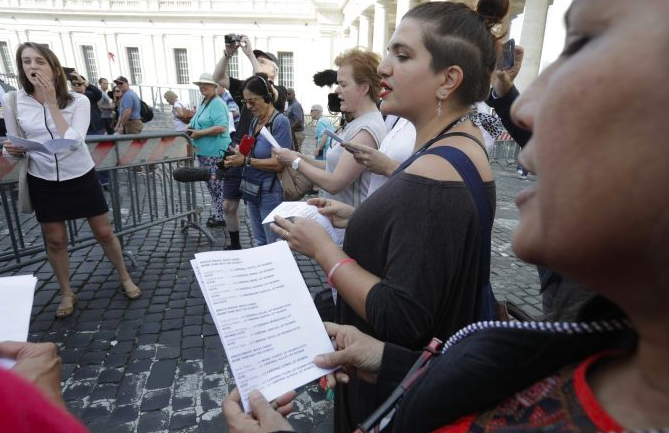Blasted!

“Blasted” is how Nicole Winfield of the Associated Press characterizes the response of the Women’s Ordination Conference to Pope Francis’s new apostolic exhortation, “Christus Vivit.” Winfield does not quote WOC’s best blast: that the Pope is “suggesting no concrete actions to further his own bishops’ call for the inclusion of women in decision-making and leadership roles in the Church.” The exhortation does not exhort!

So many newspapers and TV stations picked up the real news in the conclusion of the AP story and made it the lead:
[WOC] blasted the pope’s document for ignoring the synod’s recommendation to make the whole church aware of the “urgency of an inescapable change” to put women in decision-making roles.
The document, the group said in a statement, “offers only lip service to the movement for women’s equality in the Roman Catholic Church.”
The Synod was the October gathering about youth. The fact that the bishops and cardinals and nine religious women assembled there said more to encourage women’s leadership than the Pope does is shocking and is what the media picked up. I cannot emphasize how remarkable this is to me. After the 40 years I have spent trying to make women’s ordination newsworthy, I feel vindicated. It’s only a step to equality, but it’s a big step because it’s out in the open.
LaCroix International has the most complete examination of the whole document. It republishes Antonio Spadaro, the Jesuit editor of La Civilta Cattolica, REFLECTING THE MIND OF THE VATICAN SINCE 1850. Not a very promising venue, right? But Spadaro notes the Pope’s “move from the word ‘complementarity’ to the word ‘reciprocity,’” and goes on to say:
Complementarity seems more static and gives women one role and men another. In some way this crystalizes the relationships in a game of characterizations that do not respect the concrete life of a male-female couple.
Christian revelation puts into discussion, then, a platonic concept of human nature that interprets difference as if it were destined to disappear into the unity of love from which, by fusion, a complete human being would arise.
Any move away from complementarity is worth a cheer, despite the awkward translation. Spadaro or maybe the Pope is still heterosexist, but it’s so much better than John Paul II’s Theology of the Body.
Kevin Ahearn in America says “the letter offers an important change in tone.” While he makes no reference to gender, Ahearn focuses on the way the Pope sees young people as “the Church of Now” and calls them to responsibility.
I have to confess that I have not read the whole document; I hope I will do that soon with my Commonweal group. I am relying on summaries in various sources, most helpfully by Joshua McElwee in NCR.
Although the pope acknowledges that there has been “a fair share of male authoritarianism [and] domination” within the church, he does not reference what the Synod meeting called a “duty of justice” to include women “at all levels” of the global institution. …
[To] address the status of women within the church, the pontiff speaks in general terms, saying that a church that is “overly fearful and tied to its structures can be invariably critical of efforts to defend the rights of women.”
“A living Church can react by being attentive to the legitimate claims of those women who seek greater justice and equality,” the pope states, before continuing: “A living Church can look back on history and acknowledge a fair share of male authoritarianism, domination, various forms of enslavement, abuse and sexist violence.”
“With this outlook, she can support the call to respect women’s rights, and offer convinced support for greater reciprocity between males and females, while not agreeing with everything some feminist groups propose,” he continues.
Oh, well. There’s that “reciprocity.” And while “male authoritarianism” is not only in the past, the Pope’s knowing that it’s fear that ties some to outdated structures is good.
Francis is more concerned with the vocation and faith of young people than with their concerns about women’s issues or LGBTQ issues, which he addresses even less.
All of us want a living, lively church for young people as well as ourselves. The question is how to create it from what exists now, as so many of you wrote in your response to Ellie Harty’s post on this blog March 26. The Catholic News Service article by Cindy Wooten presents a happy view of the Pope’s letter. She captures the way young people bring enthusiasm to this continually-renewing church. May we all find this joy!

2 Responses
Don’t despair. There is a pony under the Theology of the Body. Consider this:
http://pelicanweb.org/04.19.Page24.PGTvsTOB.641.jpg
Next is the Amazonia synod. It should consider the ordination of celibate women, not the ordination of more married men. Prayers!
old lyrics from The Who describe Pope Francis perfectly – “meet the new boss, same as the old boss” as well as “don’t get fooled again”